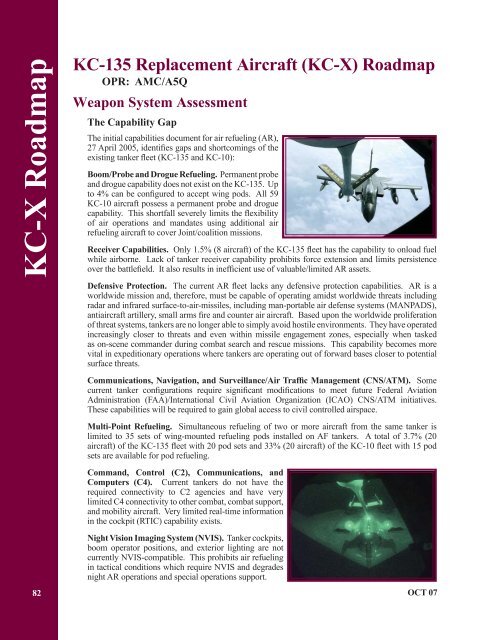Air Mobility Plan, 2008 - The Black Vault
Air Mobility Plan, 2008 - The Black Vault
Air Mobility Plan, 2008 - The Black Vault
Create successful ePaper yourself
Turn your PDF publications into a flip-book with our unique Google optimized e-Paper software.
KC-X Roadmap<br />
82<br />
KC-135 Replacement <strong>Air</strong>craft (KC-X) Roadmap<br />
OPR: AMC/A5Q<br />
Weapon System Assessment<br />
<strong>The</strong> Capability Gap<br />
<strong>The</strong> initial capabilities document for air refueling (AR),<br />
27 April 2005, identifies gaps and shortcomings of the<br />
existing tanker fleet (KC-135 and KC-10):<br />
Boom/Probe and Drogue Refueling. Permanent probe<br />
and drogue capability does not exist on the KC-135. Up<br />
to 4% can be configured to accept wing pods. All 59<br />
KC-10 aircraft possess a permanent probe and drogue<br />
capability. This shortfall severely limits the flexibility<br />
of air operations and mandates using additional air<br />
refueling aircraft to cover Joint/coalition missions.<br />
Receiver Capabilities. Only 1.5% (8 aircraft) of the KC-135 fleet has the capability to onload fuel<br />
while airborne. Lack of tanker receiver capability prohibits force extension and limits persistence<br />
over the battlefield. It also results in inefficient use of valuable/limited AR assets.<br />
Defensive Protection. <strong>The</strong> current AR fleet lacks any defensive protection capabilities. AR is a<br />
worldwide mission and, therefore, must be capable of operating amidst worldwide threats including<br />
radar and infrared surface-to-air-missiles, including man-portable air defense systems (MANPADS),<br />
antiaircraft artillery, small arms fire and counter air aircraft. Based upon the worldwide proliferation<br />
of threat systems, tankers are no longer able to simply avoid hostile environments. <strong>The</strong>y have operated<br />
increasingly closer to threats and even within missile engagement zones, especially when tasked<br />
as on-scene commander during combat search and rescue missions. This capability becomes more<br />
vital in expeditionary operations where tankers are operating out of forward bases closer to potential<br />
surface threats.<br />
Communications, Navigation, and Surveillance/<strong>Air</strong> Traffic Management (CNS/ATM). Some<br />
current tanker configurations require significant modifications to meet future Federal Aviation<br />
Administration (FAA)/International Civil Aviation Organization (ICAO) CNS/ATM initiatives.<br />
<strong>The</strong>se capabilities will be required to gain global access to civil controlled airspace.<br />
Multi-Point Refueling. Simultaneous refueling of two or more aircraft from the same tanker is<br />
limited to 35 sets of wing-mounted refueling pods installed on AF tankers. A total of 3.7% (20<br />
aircraft) of the KC-135 fleet with 20 pod sets and 33% (20 aircraft) of the KC-10 fleet with 15 pod<br />
sets are available for pod refueling.<br />
Command, Control (C2), Communications, and<br />
Computers (C4). Current tankers do not have the<br />
required connectivity to C2 agencies and have very<br />
limited C4 connectivity to other combat, combat support,<br />
and mobility aircraft. Very limited real-time information<br />
in the cockpit (RTIC) capability exists.<br />
Night Vision Imaging System (NVIS). Tanker cockpits,<br />
boom operator positions, and exterior lighting are not<br />
currently NVIS-compatible. This prohibits air refueling<br />
in tactical conditions which require NVIS and degrades<br />
night AR operations and special operations support.<br />
OCT 07
















